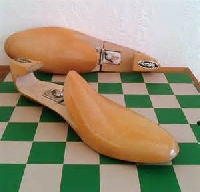Why use cedar shoe trees
By Catalogs Editorial Staff

Use cedar shoe trees to prolong the life of your favorite leather shoes
A shoe tree is a device inserted into shoes, helping maintain the original silhouette and precluding cracking and creases, as well as absorbing moisture from the lining of the shoe. The tree is similar to the shape of a foot.
When a person takes care of his shoes (are you one of those people?) it extends the life of the footwear and saves money. The answer to why you should use cedar shoe trees is very simple: They do the best job of taking care of your leather shoes.
This instrument can be acquired in plastic or wood, generally cedar. Wood is preferable to plastic because it lasts longer, maintains the footwear shape better, absorbs dampness and infuses a cedar scent into the shoe, which wipes out foul foot odors.
Wooden trees usually consist of two or three pieces of wood. A solid metal stem is inserted between the heel portion and the single or double toe pieces. The tree possesses coiled spring action, making it fit tightly into the shoe.
A handle or knob at the heel piece makes it easy for a person to grasp and remove the tree from the footwear.
~
When the utensil does not come equipped with flexing steel it may instead have extension springs or adjustable two-piece stems with an over-center mechanical action that wedges the tree into place.
The more elaborate trees have a toe flair, keeping the toe shape intact. Some feature a split toe design, which ensures shoe shaping.
Many Swear by This Item
Shoe tree aficionadoes say they absolutely maintain the natural size and shape of their footwear, which shrinks if not worn for long periods of time. The tree averts shrinkage.
Footwear is not apt to crease when this instrument is used so the shoe is going to look better, longer. The instrument also deters curling and cracking because it maintains tension in the footwear.
Sweaty Feet
Feet sweat and perspiration accumulates in the lining of the footwear, which exacerbates wear and tear as well as makes the shoe feel uncomfortable. The wooden version assists in absorption of moisture, prolonging the life of the footgear.
Feet produce more than a 1/4th cup of moisture during a normal day and up to 1/2 cup when the wearer is active. So, yes, dampness is an issue in regard to all foot gear but especially leather.
The tree pulls moisture out of the shoe, regenerating natural structural memory and thwarts cracking and creasing. When moisture is left unchecked, it gets into the lining and stays there.
Utilizing this utensil prolongs the life of leather shoes up to three times their projected life duration.
The gadget stretches footwear a tad. However, if your footwear really needs stretching invest in a stretcher.
Shoe Shopping
When spending big bucks on shoes, make certain you buy a pair that fits properly. Shop for footwear in the latter part of the day when your foot is at its biggest.
Try on the shoe. Make sure there is between 3/8th inch and 1/2 inch space at the end of your longest toe when standing.
Walk in the shoe. There should be minimal slippage. The footwear should not ride up and down the heel when you are ambulatory.
Leather shoes lessen the likelihood of skin irritation. Take this into consideration if you have sensitive skin.
The upper part of the footwear is ideally made of forgiving and supple material matching the shape of your foot. The sole should not be slippery. Thick soles cushion feet, safeguarding them from wear and tear.
Popular Savings Offers











